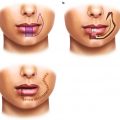Antonia Kolokythas (ed.)Lip Cancer2014Treatment and Reconstruction10.1007/978-3-642-38180-5_1
© Springer-Verlag Berlin Heidelberg 2014
1. Lip Cancer: General Considerations
(1)
Department of Oral and Maxillofacial Surgery, University of Washington, B-241 Health Sciences Bldg, 357134, Seattle, WA 98195-7134, USA
Abstract
The lips play crucial roles in speech, mastication, swallowing, maintenance of dental arch integrity, and esthetics. Therefore, cancers of the lip can lead to various functional and esthetic problems. Due to their location, lip cancers are easily detected and diagnosed at relatively early stages. As with all pathology of the oral and maxillofacial region, the role of the dental professional in early detection of lip cancers cannot be overemphasized.
Cancers of the lip occupy up to 30 % of all malignant tumors of the oral cavity. The vast majority of malignancies of the lips are squamous cell carcinoma (SCC), followed by melanoma and minor salivary gland carcinomas. The American Joint Committee on Cancer (AJCC) defines the boundaries of the lips as “the junction of the vermilion border with the skin and [including] only the vermilion surface or that portion of the lip that comes into contact with the opposing lip …joined at the commissures of the mouth,” considering only the cutaneous portions of the lips. The Union International Contre le Cancer (UICC) uses the same definition to classify lip cancers. The International Classification of Diseases for Oncology Manual, however, includes cancers of the mucosal surface in a subcategory of lip cancers, together with cancers of the oral cavity and pharynx. The variation in classification is due to the differences in histologic characteristics as well as in the environment the cutaneous and mucosal portions of the lip are exposed to (in general, carcinoma of the vermilion is thought be pathophysiologically differ from intraoral cancers and be closer to carcinoma of skin). Unfortunately, confusion exists in the data regarding lip cancers due to such variations and inconsistencies in classification.
1.1 Introduction
The lips play crucial roles in speech, mastication, swallowing, maintenance of dental arch integrity, and esthetics. Therefore, cancers of the lip can lead to various functional and esthetic problems. Due to their location, lip cancers are easily detected and diagnosed at relatively early stages. As with all pathology of the oral and maxillofacial region, the role of the dental professional in early detection of lip cancers cannot be overemphasized.
Cancers of the lip occupy up to 30 % of all malignant tumors of the oral cavity [1–3]. The vast majority of malignancies of the lips are squamous cell carcinoma (SCC), followed by melanoma and minor salivary gland carcinomas [4]. The American Joint Committee on Cancer (AJCC) defines the boundaries of the lips as “the junction of the vermilion border with the skin and [including] only the vermilion surface or that portion of the lip that comes into contact with the opposing lip …joined at the commissures of the mouth,” considering only the cutaneous portions of the lips [5]. The Union International Contre le Cancer (UICC) uses the same definition to classify lip cancers. The International Classification of Diseases for Oncology Manual, however, includes cancers of the mucosal surface in a subcategory of lip cancers, together with cancers of the oral cavity and pharynx [6]. The variation in classification is due to the differences in histologic characteristics as well as in the environment the cutaneous and mucosal portions of the lip are exposed to (in general, carcinoma of the vermilion is thought be pathophysiologically differ from intraoral cancers and be closer to carcinoma of skin). Unfortunately, confusion exists in the data regarding lip cancers due to such variations and inconsistencies in classification.
1.2 Epidemiology
Cancers of the lip make up to 30 % of all malignant tumors of the oral cavity. They also predominantly occur in the lower lip. The lower lip is affected in 85–95 % of cases, compared to the much lower incidences found in the upper lip (2–7 %) and lip commissure (1–4 %) [3]. This is presumed to be due to the higher risk of sun exposure in the lower lip associated with its anatomical location and orientation.
The incidence of lip cancer varies considerably depending on the population. In the USA, the average incidence is approximately 1.8 per 100,000; however, significantly higher rates are seen in certain parts of the country (12 per 100,000 in Utah) [7, 8]. Greater variations in incidence are seen among different regions and countries. For example, the incidence in Southern Australia is reported to be 13 per 100,000 and that of a population of fishermen in Newfoundland over 50 per 100,000 [7]. On the other hand, the overall prevalence of lip cancer is low in Asia. Age-adjusted incidences in Osaka, Japan, and Mumbai, India, have been reported to be 0.1 and 0.3 per 100,000, respectively [8]. It is important to note that direct comparison is difficult to interpret because of differences in data collection, as well as cultural and behavioral factors. Despite this, the overall annual incidence of lip cancer has shown a downward trend in many parts of the world, including the USA, and most notably Great Britain [7, 8].
Stay updated, free articles. Join our Telegram channel

Full access? Get Clinical Tree








